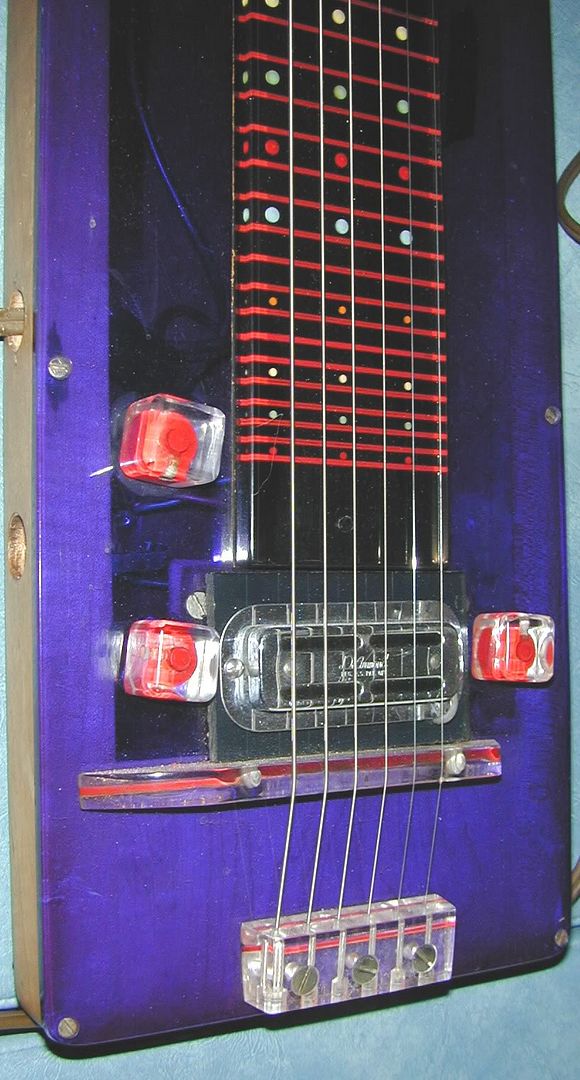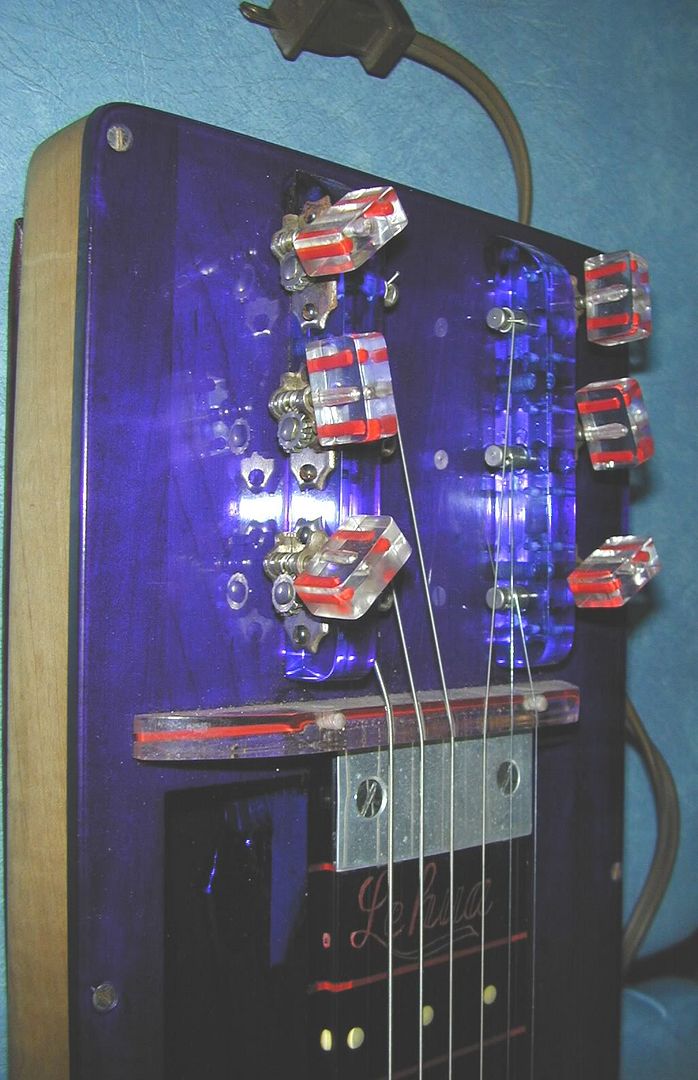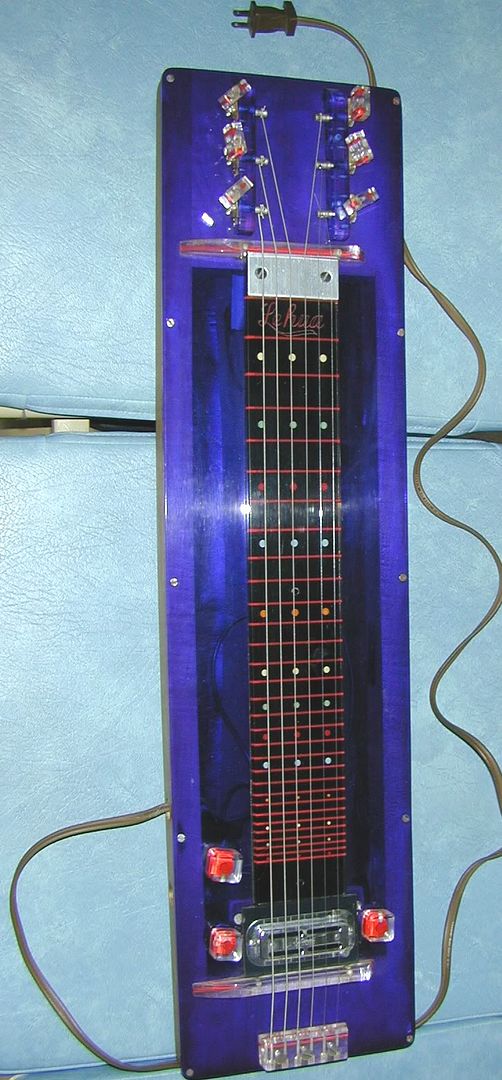Page 1 of 2
Name that Guitar Competition
Posted: 8 Sep 2008 11:18 am
by basilh
Why not a competition for fun.. unusual angles permitted but MUST contain all relevant data to identify make and model.
I'll start it off with this:-

Posted: 8 Sep 2008 11:32 am
by Mike Neer
Gibson EH-185. Very sexy guitars.
Posted: 8 Sep 2008 12:06 pm
by basilh
Well Done Mike, what year ?
It can be worked out by elimination..
Posted: 8 Sep 2008 1:53 pm
by Mike Neer
Well, it's got to be at least 1937 with the 2 knobs on one side. I can't see the pickup, but I think that appears to be grey metal...I'll say 1940.
Posted: 8 Sep 2008 1:58 pm
by basilh
You're getting there ..Ecxept for this: 1940 "metal plate has uniform thickness from fingerboard to body and is painted crinkle
brown"
Model: EH-185 LapSteel
Available: September 1939 to 1942
September 1939 EH-185 LapSteel introduction specs:
hollow guitar shaped flamed maple body, shoulder taper into neck, Charlie Christian pickup with triple bound edge, triple bound top and back, 1 piece metal plate (painted black) extends from peghead to pickguard (under fingerboard, where the plate is thicker) covering most of lower bout, peghead is part of metal plate, wood neckpiece bolts onto back of metal plate, rubber non-slip material in shape of diamonds on back of neck and body, single bound rosewood fingerboard with V-end, dot fingerboard inlays, slotted peghead, top tuners with metal buttons, sunburst or natural finish.
1940 EH-185 LapSteel specs:
metal plate has uniform thickness from fingerboard to body and is painted crinkle brown, black line on side of fingerboard binding,
1941 EH-185 LapSteel specs:
metal plate now painted black/gray crinkle, ES-300 type pickup mounted at a slant.
EH-185 discontinued 1942.
So ?
You CAN see the pick-up adjusting screws ..
And the serial number

Posted: 9 Sep 2008 6:01 am
by Dan Tyack
Here's one:

Posted: 9 Sep 2008 6:07 am
by Tor Arve Baroy
I think it is a Asher...but dont know any more specs...
Posted: 9 Sep 2008 2:19 pm
by basilh
Dan, That's a beautiful Asher "The Electro Hawaiian® Lap Steel"
As for the Gibson EH-185, it's a "Transitional model"
Between December 1940 and sometime in 1941
The serial number F611-1 is 1940, BUT, It has the 1941 metal plate painted black/gray crinkle,(Hard to make a brown 1940 one look black) BUT A Charlie Christian pickup. Can't be a modification of a 1942 model because the metal plate has a straight opening not slanted..




Posted: 9 Sep 2008 2:26 pm
by basilh
Silly double post..Much too quick on the draw!!
Posted: 9 Sep 2008 2:28 pm
by basilh
Further to the Gibson information for those interested..
Gibson Factory Order Numbers with a Letter, 1935 to 1941.
Many instruments from 1935 to 1941 have a letter designating the year within the Factory Order Number (FON).
o The FON consists of a batch number, usually 4 digits. Then there is a letter (and sometimes a space), followed by a 1 or 2 digit sequence (ranking) number.
o 1935-1937: Letter is between the batch number and the sequence number. Code is ink stamped on the inside back.
o 1938-1941: two or three letters before sequence number. Code is either ink stamped onto the label or impressed into the back of the peghead (for lap steels, impressed into the back of the body). First letter, indicates the year. Second letter, if there is one, indicates the brand of the instrument: G=Gibson, K=Kalamazoo, W=Recording King (Montgomery Wards). Third letter, if there is one, is "E" for Electric.
o Exceptions: Some high-end models and lapsteels from 1939 to 1940 have the letter A added to the prefixes D, E, or F. This includes the letters DA, EA, FA, followed by 4 digits. Examples include L-5's and Super 400's which have an EA prefix (suggesting 1939), in addition to a separate paper label indicating 1940 or 1941. In this case the later serial number is the one to believe, as the instrument was probably started and completed in different years.
Year 1st Letter
---- ----------
1935 A
1936 B
1937 C
1938 D, DA
1939 Ex (where 'x' is any other letter)
1940 F, FA
1941 E (with NO other following letter)
1941 G
1942 H
Source :-
http://www.provide.net/~cfh/gibson.html


So what's this one then ?
Posted: 10 Sep 2008 7:43 am
by Les Cook

So who can recognise what this is ?
Posted: 10 Sep 2008 8:31 am
by Steinar Gregertsen
A double top Gelas tenor guitar?
Posted: 10 Sep 2008 8:46 am
by Les Cook

Yes well done Steinar . I'm sure you are right ...thought somehow I messed up and posted the wrong photo .There's no point posting a photo of the instrument I originally intended to ...at least not from an obscure angle .So here it is in full frontal ...a 1936 Gelas Hawaienne model
Posted: 10 Sep 2008 10:00 am
by Steinar Gregertsen
That's a beautiful one you've got there! I was bidding on this one on eBay a few years ago, pretty plain compared to yours:

Posted: 10 Sep 2008 11:36 am
by Les Cook

it was made for Edouard Jacovacci , a well known player in France in the 20s and 30s . I bought it on ebay some years ago from a guy who junked it in the south of France .They have a very distintive sound !
Posted: 30 Sep 2008 9:47 am
by basilh
Posted: 30 Sep 2008 12:33 pm
by Gerald Ross
Damn it Baz...
That's the double neck that was stolen from my house last month.

You'll be hearing from my lawyers.
Posted: 30 Sep 2008 2:30 pm
by John Billings
Posted: 30 Sep 2008 3:13 pm
by basilh
Rather unusual with the coloured plastic fittings, and methinks the tuner buttons are coloured the same way !!
Maybe a Magnatone Jeweltone ?
Part III: Lucite
JewelTone
If you have an appreciation for Hawaiian guitars (why else would you be reading this?), you probably remember the first time you saw the Magnatone pictured on pg. 39 of Gruhn and Carter’s Electric Guitars and Basses, A Photographic History; the stunning red lucite body, with red-buttoned tuners and red/clear/red transluscent knobs. Available for only a short time, ca.’49-’50, the Jeweltone was the top of the line steel for its fleeting reign – and one of the most incredible examples of industrial design ever brought to fruition as a musical instrument. Three color combinations could be had, “Vibrant – Ruby Red and Crystal,” “Lovely – Sapphire Blue and Crystal,” and “Striking – Onyx Black and Opal White.”
Taken from an article by John Teagle
Or could it be a Varsity ?
The ca. ’51 catalog introduced a Varsity Matched Set featuring a revised version of the two-point guitar, “...lavishly trimmed with heavy band-cut and polished Lucite.” The extended handrest, tuner buttons, peghead decoration and control knobs were either transparent red, blue or white, depending on the MOTS and the fingerboard was contrasting Lucite, painted white on the backside, with “Varsity” between the end of the fret markers and the pickup. Even the alligator hardshell case had a clear lucite handle. A new “Whisper Sensitive” pickup sticks out of the body in a rectangular MOTS housing, but is hidden under a chrome cover. This cover differs from the Standard version by its lack of flanges on the outside edges, and was screwed into each side of the pickup instead of the face of the body. The bridge and nut are large slabs of polished metal, secured to the body with screws. Unfortunately (unless you actually needed to use them), the pots have been replaced. This was one of a number of short-lived models from the early ’50s.
Posted: 30 Sep 2008 3:45 pm
by John Billings
Right you are! Here's a pic, but you can read the name. And,,, it has lights inside it! You plug it into a wall outlet!

Posted: 30 Sep 2008 4:47 pm
by basilh
Gerald Ross wrote:Damn it Baz...
That's the double neck that was stolen from my house last month.

You'll be hearing from my lawyers.
Well Gerald !! We should get the Fender Police on this one as it's one of the 6 or so examples left of the PS-210..

Hmmm ! I thought the tuners were at the OTHER end ?


Posted: 30 Sep 2008 4:56 pm
by Alan Brookes
I avoided giving the game away, since I'd seen the instrument "in the flesh" and you'd pointed out all its virtues to me with great satisfaction.

Posted: 30 Sep 2008 4:58 pm
by Jeremy Threlfall
basilh wrote:Rather unusual with the coloured plastic fittings, and methinks the tuner buttons are coloured the same way !!
Maybe a Magnatone Jeweltone ?
Similar to this late 40's Lehua (from North Coast Guitars websire, Australia)

Posted: 30 Sep 2008 5:11 pm
by basilh
It would appear that they made various variations of that model,
Notice the DeArmond toaster style pickup on this example of Richard Shatz's



3 knobs ? maybe Tone .. Volume ... and Lights ?
Posted: 30 Sep 2008 5:20 pm
by basilh
Alan, if I recall correctly, you played that Fender PS-210 a couple of years ago at an upstairs soiree in Mere Green !
























